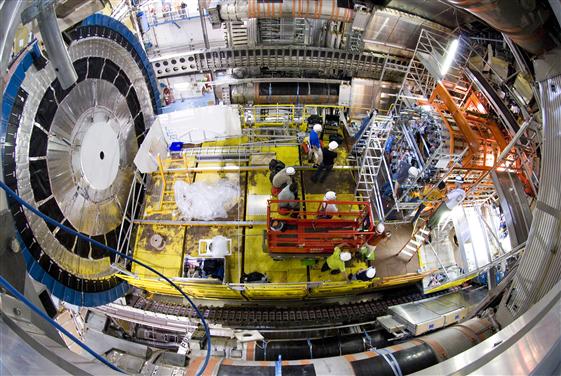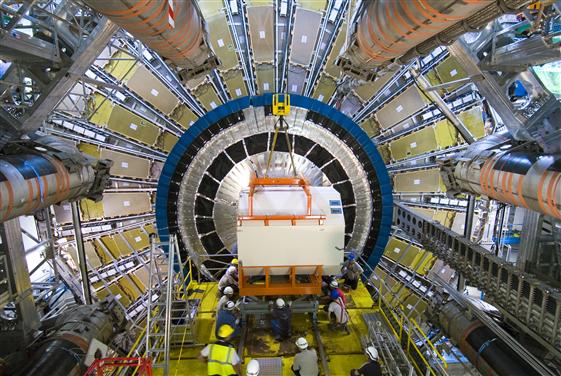ATLAS end-caps on the move
Two delicate and spectacular transport operations have been performed for ATLAS in recent weeks: the first end-cap tracker was installed in its final position, and one of the huge end-caps of the toroid magnet was moved to the top of the experiment’s shaft.
On 29 May, the first Inner Detector End-Cap was installed in the heart of the ATLAS experiment, just 25 centimetres away from the beam. The installation was conducted by the team led by Andrea Catinaccio, the Inner Detector project engineer.
The 2-metre-long, 1350-kilogramme end-cap tracker is actually two detectors in one. On the inside of the structure is the Semiconductor Tracker (SCT), a silicon detector whose 80-micrometre-wide strips of silicon are arranged in a radial pattern along a total of nine disks, stacked vertically like music records on a shelf. Surrounding the SCT is the Transition Radiation Tracker (TRT), a wire chamber, each of whose wires is suspended within a long, skinny, gas-filled straw. Together with the Pixel Detector to be installed later this year, the SCT and TRT end caps will reveal the tracks and measure the momenta of charged particles flying through the forward regions of the detector at angles close to the beam pipe.
"One of the greatest challenges was building a detector whose structure is virtually invisible to the particles that pass through it", explains Patrick Werneke, the ATLAS SCT End-Cap project engineer. This forced engineers to turn to materials whose low density makes them delicate and difficult to work with. These include large support structures made of special composite materials as well as the hundreds of metres of copper and nickel pipes, only 70 micrometers thick, which are needed to transport the coolant fluid.
The result is that getting the detector over to the ATLAS cavern at Point 1 was a delicate task indeed. To preserve the detector from corrosive condensation, engineers had to seal the detector hermetically and flush it with dry air for the extent of its day-long journey. On 25 May, the detector was relayed across the parking area by an assembly line of cranes—one to carry the detector from the doorway of the clean room to the parking area, another to lift it from the parking area to the entrance of Point 1, and a third to lower it the 100 metres into the cavern itself. The forces on the detector were monitored throughout this complex journey to guarantee that no acceleration greater than 0.2 g was applied.
However this was not the end of the journey as it took another four days to move the last couple of metres to the detector’s final position. "Despite all the preparatory work, the final docking inside the magnet and the liquid argon cryostat was particularly challenging", says Andrea Catinaccio. "It required the skill and dedication of the installation team throughout the Whit week-end."
The next big spectacular transport operation for ATLAS will be the lowering of its huge magnet end-cap after its journey from the assembly hall on the Meyrin site to the top of the experiment’s shaft.



